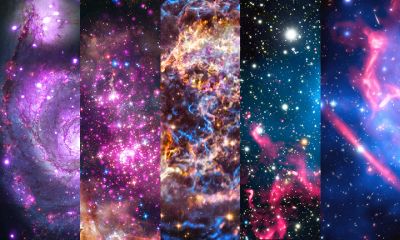GAM 2019 Blog
by Megan Watzke & Kim Arcand
- Published: Friday, April 05 2019 02:51

Celebrating 20 years of NASA's Chandra X-ray Observatory
(Illustration: NASA/CXC & J.Vaughan)
Since its launch on July 23, 1999, the Chandra X‐ray Observatory has helped revolutionize our understanding of the Universe. As NASA’s flagship mission for X‐ray astronomy and part of the “Great Observatories,” Chandra is a telescope designed to detect X‐ray emission from very hot regions of the Universe such as exploded stars, clusters of galaxies, and matter around black holes.
Because X‐rays are absorbed by Earth’s atmosphere, Chandra orbits high above it. Its elliptical path takes the spacecraft from just under 16,000 km (10,000 miles) on its closest approach out to a distance of 139,000 km (86,500 mi) from Earth.
Chandra carries four very sensitive mirrors nested inside each other. X‐rays from space, which are highly energetic, strike the insides of the hollow shells and are focused onto electronic detectors at the end of the 9.2-meter (30‐foot) optical bench. Depending on which detector is used, very detailed images or spectra (the amount of X-rays over a range of wavelengths) of the cosmic source can be made and analyzed.
Chandra has the ability to make exquisite X‐ray images of star clusters, supernova remnants, galactic eruptions, and collisions between clusters of galaxies. This has allowed scientists using Chandra to probe the geometry of space‐time around black holes, trace the dispersal of elements by supernovas, and reveal whirling neutron stars generating streams of high‐energy particles. The telescope has also been used to study cosmic phenomena as diverse as comets and planets in our Solar System to the effects of dark matter and dark energy on the Universe itself.
As Chandra expands the realm of the known, it continues to raise new questions and point the way for future exploration. To commemorate Chandra’s 20 years in space, we’ve put together 20 facts about Chandra. This, of course, is just a sample of all of the wonderous things Chandra has done and can do in the future.

Credit: NASA/CXC/SAO
20 (Facts) for 20 (Years) with Chandra
- NASA’s Chandra X‐ray Observatory was launched aboard the Space Shuttle Columbia on 23 July, 1999
- Eileen Collins commanded the mission, known as STS-93, the first woman to be in charge of a Shuttle
- Chandra’s oval‐shaped orbit takes it tens of thousands of miles away from Earth – 1/3 the distance to the Moon – at its farthest point
- Chandra is NASA’s premier X‐ray telescope, belonging to a special class called the ‘Great Observatories’ (along with Hubble, Spitzer, and Compton)
- The Great Observatories took decades to plan, develop, and build. Each has given astronomers a unique view of the Universe in different types of light
- Chandra has observed black holes of all sizes, from nearby to the edge of the known Universe
- Chandra has seen giant eruptions from the supermassive black holes that reside at the centers of most galaxies – including our own
- When matter swirls around a black hole, it is superheated to millions of degrees. This makes it glow brightly in the X‐ray light that Chandra can detect
- Black holes can rip apart stars that approach too close, and Chandra has observed the aftermath of these violent event
- Chandra has helped to reveal the fundamental properties – spin and mass – of black holes
- Galaxy clusters are the largest objects in the Universe held together by gravity. Most of their normal matter is in hot gas between the galaxies that emit X‐rays
- Chandra sees the hot gas in clusters in more detail than any other telescope, making discoveries like the deepest known note in the Universe within the Perseus Cluster
- Studies of galaxy clusters with Chandra have given scientists clues about the nature of dark matter and dark energy, two of the biggest mysteries in astrophysics
- Many of the elements necessary for life are forged inside stars and blasted into space in supernovas. Chandra has tracked these elements with exceptional accuracy
- The study of these debris fields, known as supernova remnants, gives astronomers a way to understand the life cycle of star life, death, and rebirth
- Chandra can study stars of different ages and sizes, enabling a better understanding of the past, present, and future of our own Sun and nearby stars
- Astronomers have used Chandra to learn about how exoplanets are affected by X‐rays from their host stars
- X‐rays from Chandra have told us new things about planets, comets, moons and other objects within our own Solar System
- Chandra observed X‐rays resulting from a merger between two neutron stars that generated gravitational waves, the birth of a new era in studying the Universe
- In 2018, Chandra became the longest running astronomy mission in space without maintenance or repair from astronauts.
Here’s to another 20 years!
| Megan Watzke is the public affairs officer for the Chandra X-ray Observatory, a position she has held since 2000. Her responsibilities include the dissemination of Chandra’s science results to the general public through press releases, press conferences, informal education, and other activities. |  |
| Kimberly K. Arcand is the Visualization Lead for NASA’s Chandra X-ray Observatory, which has its headquarters at the Smithsonian Astrophysical Observatory in Cambridge, Massachusetts. She studies the perception and comprehension of data visualization across the novice-expert spectrum and is active in the creation, distribution, and evaluation of large-scale science and technology communications projects. |  |






